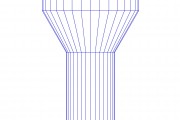 Shortly after receiving a drawing program, Paint Shop Pro, I had to come up with an illustration of the concept for an oilwell tool. I had no one to ask, so I had to come up with my own solution, which entailed viewing the subject from above, in plan view. I then drew radii and where they cut the circle I projected them back to the ‘horizontal’. When the subject was rotated, 90 degrees, to a side elevation, the edge of the facet was then measured out. I had no idea if this was correct from a Technical Drawing or Draughting practice, but it worked well enough to give a 3D appearance to a 2D drawing. By adjusting the diameter and connecting facets I could create cones, recesses, chamfers, etc. By using layers I could alter the tone value of a flat colour or textures, using the guidelines of a template placed above it. This was long before 3D programmes do all this for you automatically.
Shortly after receiving a drawing program, Paint Shop Pro, I had to come up with an illustration of the concept for an oilwell tool. I had no one to ask, so I had to come up with my own solution, which entailed viewing the subject from above, in plan view. I then drew radii and where they cut the circle I projected them back to the ‘horizontal’. When the subject was rotated, 90 degrees, to a side elevation, the edge of the facet was then measured out. I had no idea if this was correct from a Technical Drawing or Draughting practice, but it worked well enough to give a 3D appearance to a 2D drawing. By adjusting the diameter and connecting facets I could create cones, recesses, chamfers, etc. By using layers I could alter the tone value of a flat colour or textures, using the guidelines of a template placed above it. This was long before 3D programmes do all this for you automatically.
Using this simple drawing procedure I started a series of sketches for ceramic pieces. They were based on the basic language of down-hole tools. The langage first comes from the need for strength, that there is enough material to stand up to the forces, stress relief to make sure it doesn’t snap and then ease of manufacture. There is another aspect which tells you on the outside how it is put together on the inside. They are purely functional pieces of equipment, they have no aesthetic qualities applied to them, they are not styled in the least. Consequently these tools have an appearance and form that is totally their own. I first had to build the machinery to make them, which I did eventually start, but circumstances overtook that project

I did keep the idea of portraying an object by rotating from the profile to the cross section and back again. . The first project to fully use this was the Super Mileage car which was nicknamed “The Blimp”. I drew up a NACA 63 profile and scaled it until the shoulders of the driver fitted inside and the rear wheels also. The chassis was divided into bulkheads to carry loads from the wheels and the drivers weight. The upper body was divided by into stations. This is how boats and planes have been designed for decades. The chassis is an extrusion of the NACA 63 in that it is straight sided and is the same cross section looking from above, it is pulled up. The upper body is the same profile but rotated 180 degrees, it is spun along it’s length.
The head faring is NACA 63 but rotated and scaled to allow the driver to turn his head, and still keep the minimum 4:1 ratio, it is 4 time longer than it wide. It is both spun and extruded. A lathe works by spinning material and applying cutters to achieve the profile. A mill cuts depths vertically and horizontally and can achieve an ‘extruded’ result. This is how the 3D drawing programmes I have used work. Draw a profile, spin it and it looks like a lightbulb, or a wheel, or a bowl. Draw a circle and extrude it and it becomes a column, a rectangle and it becomes a house brick or a table top.
 By using a calculated aero profile like the NACA 63 I was trying to give myself the best chance of a aerodynamically clean shape without having to pay for wind tunnel time, I did not have a Formula 1 budget. These curves have a tension that comes from guiding the path of the air as the object moves through it. If the curve is not right it stops guiding and starts disturbing the air until it can be as bad as if there was nothing there at all.
By using a calculated aero profile like the NACA 63 I was trying to give myself the best chance of a aerodynamically clean shape without having to pay for wind tunnel time, I did not have a Formula 1 budget. These curves have a tension that comes from guiding the path of the air as the object moves through it. If the curve is not right it stops guiding and starts disturbing the air until it can be as bad as if there was nothing there at all.

You have a talent for making technical drawing look elegant and graceful.
Beautiful graphics on the ceramics pieces.